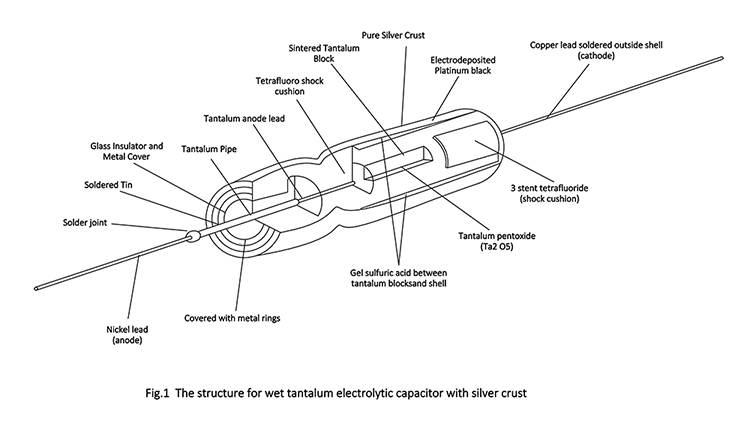Wet tantalum electrolytic capacitors have excellent electrical performance. Among all electrolytic capacitors, the leakage current is the smallest, the product of CU per unit volume (the product of capacitor and rated voltage) is the largest, which is more than 5 times larger than that of the same volume and other capacitors. Therefore, they are widely used in the electronic circuits for computers, communication equipment, radar, aircraft, ships, precision instruments, computers, EMC, mining equipment and etc.
Structural features of Wet Tantalum Electrolytic Capacitors
1. The working medium of wet tantalum electrolytic capacitor is a very thin layer of Ta2O5 film that formed on the surface of tantalum core. This layer of dielectric oxide film and tantalum are combined into a whole, which can not exist alone.
2.The anode of the wet tantalum electrolytic capacitor is the metal tantalum that produces the dielectric oxide film in the capacitor, which makes the capacitor connect to the positive pole of the application in the circuit.
3. The actual cathode of a wet tantalum electrolytic capacitor is a working electrolyte, including impregnated electrolyte (wet) and gel electrolyte (gel). In order to connect the cathode with the outside and contact the electrolyte with another metal shell, this is the negative pole of the Wet tantalum electrolytic capacitor when it is connected to the circuit and only plays the role of leading out the cathode
Structure of Wet Tantalum Electrolytic Capacitors

1. Tantalum core and dielectric oxide film
Tantalum core is the anode of wet tantalum capacitor. It is a cylinder made of tantalum powder by pressing and sintering. A tantalum wire is led out at the center of one end of the cylinder to access the positive pole of the circuit. The opening during sintering greatly affects the capacity and loss of tantalum capacitors. Ta2O5 oxide film with a thickness of tens to hundreds of nanometers is formed on the surface of tantalum core by enabling. The oxide film exists in an amorphous state, making a large number of honeycomb like voids on the surface of tantalum core. The oxide film is the heart of electrolytic capacitor. Its quality is related to the performance of capacitor, especially the leakage current.
2. Silver shell
Wet tantalum electrolytic capacitors usually use high-purity silver shell as the cathode of the capacitor, which is the cathode when the capacitor is connected to the circuit. The inner surface area of the untreated silver shell is small, which makes the capacitance difficult to be led out, so the cathode surface area should be increased. To solve this problem, chemical or electrochemical corrosion methods can be used, such as sulfuric acid, nitric acid, etc. But these corrosives are too strong in oxidation, too fast in corrosion speed, and the effect is difficult to control, which may cause the shell mouth to be corroded, thus affecting the sealing performance of the capacitor. Another method is to deposit a sponge like platinum black layer on the inner wall of the silver shell by electroplating or electrochemical plating, but the platinum black layer is easy to fall off. At present, all tantalum full sealed structure is generally used, and a layer of porous carbon is deposited on the inner wall of the silver shell to increase the effective area of the cathode.
2.Working electrolyte
Working electrolyte is the actual cathode of tantalum capacitor. It is in full contact with the Ta2O5 dielectric film on the surface of tantalum anode and the inner wall of silver shell. Its physical and chemical properties have an important impact on the electrical properties of the capacitor. The working electrolyte of wet tantalum electrolytic capacitors includes two parts: impregnated electrolyte and gel electrolyte. One part is to impregnate the electrolyte, which is used to impregnate the tantalum core, so that the electrolyte solution can penetrate into the porous anode tantalum block to lead out the maximum capacitance. It needs to have good wettability, constantly provide the electrochemical ability to repair the oxide film of the medium in the work, and the change of its conductivity and viscosity in the specified temperature range should be small and stable, the boiling point and ice point are outside the working temperature range, the higher flash voltage and the lower saturated vapor pressure. The other part is gel electrolyte. After cooling, it is gelatinous and has a shaking property. It fills the tantalum core and the silver shell to play a role in the connection between them and prevent leakage of capacitors.
Characteristics of wet tantalum electrolytic capacitors:
1. Smaller volume than aluminum electrolytic capacitor
2. Wide working temperature range
GTCAP brand wet tantalum electrolytic capacitors can work in the range of - 55 ℃ ~ + 155 ℃. Some can even work at + 200 ℃.
3. Low leakage current, low loss, high insulation resistance and good frequency characteristics
4. Large capacity, long life, can be made into ultra small components.
5. Stable electrical performance
Because of the stable chemical properties, acid and alkali resistance of tantalum oxide film, the performance of tantalum electrolytic capacitor is stable, and it can still maintain good electrical performance for a long time.
5. Polarity, low voltage resistance













